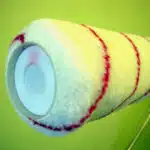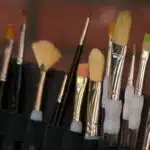When it comes to painting a high ceiling, many homeowners and DIY enthusiasts are often intimidated by the task. However, with the right tools, techniques, and preparation, painting a high ceiling can become a manageable and fulfilling project. As a professional painter with years of experience in residential and commercial settings, I have come across various challenges in painting high ceilings. In this article, I will share some tips and tricks that will help you achieve a flawless finish on your high ceilings.
Firstly, painting a high ceiling requires careful planning and preparation. Before you start painting, make sure that you have all the necessary supplies such as paint rollers, extension poles, drop cloths, and ladder stabilizers. It is also essential to clean the ceiling surface thoroughly to remove any dust or debris that may affect the quality of your paint job. Additionally, consider using an angled brush to cut in around edges or corners before applying the roller for easy coverage. By taking these steps into account and following proper techniques for cutting in around trim work or fixtures on your high ceilings, you can ensure that your finished product will be both functional and aesthetically pleasing.
Assessing The Ceiling Height
Measuring techniques and safety precautions are crucial when painting a high ceiling. Before beginning, assess the height of the ceiling to determine the appropriate equipment needed for safe and efficient completion of the project. A ladder is essential but may not be sufficient for ceilings over 10 feet high.
For ceilings higher than 10 feet, an extension ladder or scaffold system is necessary to ensure safety. Extension ladders have adjustable sections that allow them to reach higher areas, while scaffold systems provide a wider working platform and increased stability. It’s important to choose the right equipment for the job as using an unsuitable ladder or scaffold could lead to accidents.
As with any painting project, safety should always come first. Ensure that all equipment is secure and stable before starting work, wear non-slip shoes with good grip, and consider renting specialized safety harnesses if you’re uncomfortable working at heights. By taking these precautions and measuring accurately, you’ll be on your way to safely painting your high ceiling.
When it comes to gathering necessary supplies, having the right tools is key in ensuring a successful paint job.
Gathering Necessary Supplies
Before beginning to paint high ceilings, it is crucial to gather all necessary supplies to ensure a smooth and efficient painting process. Having the appropriate tools and materials at hand can also prevent unnecessary trips up and down ladders, saving time and reducing potential safety hazards.
Firstly, consider investing in a sturdy ladder that reaches the height of your ceiling. A ladder with adjustable legs is ideal for uneven surfaces, while one with a platform step can provide extra stability. Additionally, choose a high-quality paint roller with an extension pole that allows you to reach the topmost areas without straining your arms or neck.
Painting techniques are another important aspect of successfully painting high ceilings. Begin by cutting in along the edges of the ceiling using a brush before using a roller for larger areas. Work in sections from one end of the room to another, ensuring each section is completely dry before moving on to avoid smudging or dripping.
Safety precautions must also be taken seriously when painting high ceilings. Wear appropriate clothing such as long sleeves and pants to protect skin from accidental spills or splatters. Eye protection and a face mask should also be worn when sanding or working with chemicals such as paint thinners. Always have someone nearby as an extra set of hands or in case of emergencies.
When gathering supplies for painting high ceilings, remember that preparation is key to achieving professional results safely and efficiently. By following proper techniques and taking necessary precautions, any DIY painter can tackle this task with confidence and ease.
To prepare the room for painting high ceilings, it is important to clear out any furniture or objects that may get in the way during the painting process. Cover remaining items with drop cloths or plastic sheets to protect them from accidental drips or spills. Open windows if possible for proper ventilation and use fans to circulate air throughout the room.
Preparing The Room
To properly paint a high ceiling, it is important to prepare the room beforehand. This will not only make the process smoother, but also ensure that the final outcome is of high quality. The first step in preparation is to measure the height of the ceiling. This will determine whether or not you need to use a ladder or scaffolding, and will help you estimate how much paint you will need.
Next, it is important to cover and protect any furniture or flooring with drop cloths. This will prevent any accidental spills or splatters from ruining your belongings. It is recommended to use canvas drop cloths as opposed to plastic ones, as they are more durable and can be reused for future projects. Additionally, remove any light fixtures or fans that may get in the way of painting.
Finally, before beginning to paint, make sure that the ceiling is clean and free of any dust or debris. Use a vacuum cleaner or microfiber cloth to remove any cobwebs or dirt that may have accumulated over time. By properly preparing the room beforehand, you can ensure that your painting project goes smoothly and without any hiccups.
Transition: Now that the room has been prepared for painting, it’s time to move on to cleaning the ceiling itself in order to achieve a smooth finish.
Cleaning The Ceiling
Preparing the room before painting is an essential part of any painting project. It is like sharpening your tools before starting work on a piece of art. The preparation ensures that the outcome is perfect, and all necessary precautions are taken to avoid making mistakes. Once you have prepared the room, it’s time to clean the ceiling before painting.
Cleaning methods for high ceilings differ depending on the type of ceiling you have. If it’s made of plaster, you can use a damp cloth or sponge to remove dirt and dust from the surface. However, if your ceiling has been painted with oil-based paint, it will require a different cleaning approach. You can use TSP (trisodium phosphate) and warm water to break down grease and oil stains on the surface.
Safety precautions should be taken while cleaning high ceilings. It’s recommended that you wear protective clothing such as gloves, goggles, and a respirator mask to keep harmful chemicals away from your skin and lungs. Make sure that you place drop cloths under the area where you’ll be working to catch any debris that might fall while cleaning. Additionally, ensure that all electrical switches are turned off while working near light fixtures or fans.
4 Cleaning Tips for High Ceilings:
- Always start by removing cobwebs and dust using a long-handled duster.
- Use a sturdy ladder specifically designed for high ceilings to avoid accidents.
- Avoid using harsh chemicals that could damage the paint or plaster.
- Clean in small sections at a time to avoid getting overwhelmed by the task.
Once you’ve cleaned your high ceiling thoroughly, it’s time to set up the ladder carefully for painting purposes without causing any damage or injury risk.
Setting Up The Ladder
Choosing the right ladder is crucial when it comes to painting high ceilings. It’s important to choose a ladder that will allow you to comfortably reach the ceiling without stretching or overreaching. A ladder that is too short will make the job difficult, while a ladder that is too long can be dangerous.
Safety measures should also be taken into consideration when setting up the ladder. Make sure that the legs of the ladder are secure on a stable surface and that it is set at an appropriate angle. Always make sure to have someone hold the bottom of the ladder for added stability. Additionally, never stand on the top rungs of the ladder, as this can lead to accidents.
Using a ladder stabilizer can provide additional safety when painting high ceilings. This accessory attaches to the top of your ladder and helps distribute your weight more evenly, providing greater stability when working at higher heights. By using a ladder stabilizer, you can focus on painting rather than worrying about losing your balance.
Using A Ladder Stabilizer
With high ceilings come grandeur and elegance, but also the daunting task of painting them. Climbing up a tall ladder to reach the ceiling can be a nerve-wracking experience, especially for those who are not accustomed to heights. However, with the proper equipment and knowledge of safety measures, painting high ceilings can be accomplished with ease.
Using a ladder stabilizer is essential when painting high ceilings. It provides additional support and stability to the ladder, preventing it from wobbling or tipping over. This simple piece of equipment can make all the difference in ensuring safety while working at heights.
When using a ladder stabilizer, keep these safety precautions in mind:
- Always ensure that the ladder is securely anchored before climbing
- Never exceed the maximum weight limit recommended by the manufacturer
- Do not lean too far to either side while on the ladder
- Wear appropriate footwear with non-slip soles
Now that you have learned about using a ladder stabilizer, it’s time to move onto choosing the right paint for your high ceilings. With careful consideration and preparation, you’ll soon be able to transform your space into a stunning masterpiece.
Choosing The Right Paint
When it comes to painting high ceilings, choosing the right paint is crucial. One of the most important factors to consider is the paint finish. High gloss and semi-gloss finishes are ideal for high ceilings because they reflect more light and create an illusion of height. Meanwhile, matte finishes can make a room feel cozier but may not be suitable for large spaces.
Another factor to consider when choosing paint is color coordination. It’s important to select colors that complement each other and enhance the overall aesthetic of the room. For example, if you have dark furniture or flooring, it may be best to choose a lighter color for your ceiling to balance out the space. Alternatively, if your walls are neutral, you can experiment with bolder ceiling colors for a more dramatic effect.
In summary, selecting the right paint finish and color coordination are essential components when painting high ceilings. A glossy finish adds height while matte creates warmth in a room. With regard to color coordination, it’s important to choose complementary colors that accentuate the overall design of the space without overpowering or clashing with existing elements. In the next section, we’ll discuss how to test your chosen paint color before committing to painting your entire ceiling.
Testing The Paint Color
Choosing the right paint for your high ceilings is just the first step in achieving a perfectly painted space. Once you have decided on the paint type and finish, it’s important to test the color swatch in your room under different lighting effects. This will help you see how the color reacts to natural light, artificial light, and shadows.
When testing your paint color, it’s essential to view it at different times of day. You might be surprised how much colors can change depending on the amount and type of light that enters your room. Additionally, consider purchasing a small sample of paint and applying it to a discreet area of your ceiling before committing to a full coat. This will give you an idea of how the color looks once dry.
To ensure a professional-looking finish, here are some tips for painting high ceilings:
- Use an extension pole for rollers to reach high up.
- Apply thin coats instead of one thick coat to avoid drips and unevenness.
- Cover furniture and floors with drop cloths or plastic sheets.
- Cut in around edges and corners before rolling on paint.
Cutting in around edges and corners can be challenging, but it’s an essential step that will make all the difference in achieving a neat and polished look. In the next section, we’ll discuss techniques for cutting in like a pro so that you can confidently tackle this crucial aspect of painting high ceilings.
Cutting In Around Edges And Corners
- Preparing the edges and corners of a high ceiling before painting is an important step, as it allows for more accurate and cleaner lines.
- Cutting in with brushes requires a steady hand and a brush with a fine edge, such as a sash brush, to ensure a smooth line.
- Applying tape to areas near the ceiling can also help keep lines clean, as long as it is applied properly and removed while the paint is still wet.
- When using a brush, it is important to continuously dip the brush into the paint, as this will ensure a consistent flow and result in a smoother line.
- If mistakes are made, use a damp cloth to quickly remove the paint before it dries, wiping gently along the edge of the line to remove any excess.
- For larger mistakes, a putty knife or razor blade can be used to carefully scrape off the paint, following the edge of the line where necessary.
Preparing Edges
Before you start painting high ceilings, it is important to prepare the edges properly. Edge taping is a technique that can help ensure clean, straight lines around corners and edges. To do this, apply painter’s tape along the edge or corner before starting to paint. This will prevent any accidental overpainting onto adjacent walls or ceilings.
Another important aspect of preparing edges is selecting the right brush for cutting in. Choose a brush with angled bristles that are firm enough to hold their shape, but not so stiff that they leave brush marks on the wall. The size of the brush should be appropriate for the size of the area being painted. For example, use a smaller brush for tight spaces and a larger one for wider surfaces.
When cutting in around edges and corners, it is important to use the proper cutting technique to achieve professional-looking results. Start by loading your brush with paint and then carefully draw it along the edge or corner with steady pressure. Try not to put too much pressure on the brush as this can cause drips and smudges. Use a steady hand while painting, moving slowly and carefully to ensure even coverage without overlapping onto adjacent surfaces.
By taking these steps to prepare edges properly, you can achieve a professional-looking finish when painting high ceilings without worrying about unsightly drips or smudges around corners and edges. Remember to choose the right roller cover size when applying paint to large areas and always work carefully and methodically for best results.
Cutting In With Brushes
When it comes to painting high ceilings, cutting in around edges and corners can be a challenging task. However, with the right brush techniques and correct brush size, achieving professional-looking results is possible. To start, choose a brush with angled bristles that are firm but not too stiff to avoid leaving brush marks on the wall. The size of the brush should also be appropriate for the area being painted.
When cutting in around edges and corners, it’s important to use the proper technique. Begin by loading your brush with paint and then carefully draw it along the edge or corner with steady pressure. Avoid putting too much pressure on the brush as this can cause drips and smudges. A steady hand while painting slowly and carefully will ensure even coverage without overlapping onto adjacent surfaces.
Using a smaller brush for tight spaces and a larger one for wider surfaces is also crucial when cutting in around edges and corners. This will help achieve precise lines without making any mistakes or overpainting onto adjacent walls or ceilings. Practicing these techniques will enable you to achieve professional-looking results when painting high ceilings with ease.
Cleaning Up Mistakes
When it comes to painting high ceilings, cutting in around edges and corners can be a challenging task for any painter. However, with the right painting techniques and equipment maintenance, achieving professional-looking results is possible. In the previous subtopic, we have discussed the importance of using the proper brush size and technique when cutting in around edges and corners. Now let’s talk about cleaning up mistakes.
Even the most experienced painters make mistakes while painting, especially when cutting in around edges and corners. Fortunately, there are ways to clean up these mistakes without ruining the entire paint job. One solution is to use a damp cloth or sponge to wipe off any excess paint immediately after making a mistake. This will prevent the paint from drying and becoming difficult to remove.
Another method is to wait until the paint has dried completely and then use a razor blade or sandpaper to gently scrape away any excess paint from unwanted areas. It’s important to be cautious when using these tools as they can damage adjacent surfaces if not used carefully. By practicing these cleaning methods, you can quickly fix any mistakes that may occur while cutting in around edges and corners.
Cleaning up mistakes when painting high ceilings requires patience and practice but it’s an essential part of achieving a professional-looking finish. By incorporating proper equipment maintenance, such as cleaning your brushes after each use, you can avoid making more mistakes during your painting project. Remember that even professionals make mistakes, but with the right techniques and tools, you can easily correct them without sacrificing quality workmanship.
Rolling The Ceiling
Choosing the right roller is crucial when painting high ceilings. A roller with a thicker nap will hold more paint, allowing for fewer trips up and down the ladder. However, it may also leave more texture and result in roller marks. On the other hand, a thinner nap will produce a smoother finish but may require more frequent reloading of paint.
To avoid roller marks, it is important to maintain a wet edge while rolling. This means overlapping each pass with the roller slightly onto the previous pass before it dries. Additionally, start rolling in an area that is not directly above your head to avoid drips and splatters. It may also be helpful to use a smaller roller for areas closer to the wall or trim where a larger one may be too cumbersome.
In summary, selecting the appropriate roller and technique can make all the difference when painting high ceilings. Avoiding roller marks requires attention to detail and patience but can result in a professional-looking finish that will last for years to come.
Transition into subsequent section about ‘using an extension pole’: To further simplify this process, using an extension pole can help reduce strain on your arms and back while reaching high areas without having to climb up and down the ladder as frequently.
Using An Extension Pole
When you’re painting a high ceiling, using an extension pole can be a game-changer. It’s like having an extra-long arm that allows you to reach those hard-to-get places without having to climb up and down a ladder constantly. Using an extension pole not only saves time but also reduces fatigue, making it easier to maintain a steady hand while painting.
Here are some tips for using an extension pole:
Choose the right length: Extension poles come in various lengths, from 2 feet to 16 feet or more. Pick one that is long enough to reach your high ceilings without being so heavy that it becomes difficult to control.
Attach the roller frame: Most extension poles come with a threaded end that fits most paint roller frames. Make sure you securely attach the roller frame before starting to paint.
Use safety precautions: When using an extension pole, always make sure it is secured tightly before beginning to paint. Also, be aware of your surroundings and avoid hitting light fixtures, ceiling fans, or other objects in the room.
Extension pole alternatives: If you don’t have an extension pole handy, there are other options available such as telescoping ladders or scaffolding systems that can provide similar functionality.
By following these tips, you’ll be able to use an extension pole safely and effectively during your next painting project. In the next section, we’ll discuss how to apply a second coat of paint for optimal coverage and durability without having any streaks or uneven spots on your walls or ceilings.
Applying A Second Coat
Using an Extension Pole can be a great help for painting high ceilings, but it’s not enough to achieve the perfect finish. Applying a second coat is crucial for uniformity and coverage. Before applying a second coat, make sure the first coat is completely dry. It usually takes around 4 hours for latex paint to dry, while oil-based paints may take up to 24 hours. To ensure that the paint is fully dry and ready for another coating, gently touch a small area of the painted surface with your finger. If it feels sticky or tacky, then it’s not yet ready.
Tips for applying a second coat include using the same type of paint as the first coat and making sure to stir it well before use. You can also add a paint conditioner to prevent brush strokes and roller marks. Apply the second coat in the same manner as you did with the first one, starting from one corner of the ceiling and working your way towards the other side. Avoid overloading your brush or roller to prevent dripping or splattering.
When to apply a second coat depends on various factors such as humidity, temperature, type of paint used, and desired finish quality. However, most painters recommend waiting at least 4 hours between coats for latex paints and 24 hours for oil-based paints. Applying two or more coats will result in better coverage and durability of your painted ceiling.
To achieve professional-looking results when painting high ceilings, preparation is key, but so is cleaning up after painting. In the next section, we’ll discuss how to properly clean your tools and workspace after completing your project.
Cleaning Up After Painting
Post painting maintenance is essential for ensuring that your high ceilings look great for years to come. Before you begin cleaning up, make sure that the paint has dried completely. This will prevent smudging or ruining the finished product. Once the paint has dried, remove any painter’s tape used to protect edges and trim. Be sure to do this slowly and carefully so as not to damage the newly painted surface.
Preventing paint splatters is key in keeping your workspace clean during and after painting. Cover all furniture, floors, and surrounding areas with drop cloths or plastic sheets before beginning your project. Additionally, invest in a quality paintbrush or roller that will help reduce splattering. Use a steady hand when painting near edges and take your time when rolling over textured surfaces such as popcorn ceilings.
After you have completed cleaning up after painting, it’s important to inspect the finished product for any imperfections or missed spots that need touch-ups. Lightly run your hand over the surface to feel for any rough patches or bumps. You can also use a flashlight to check for areas where light may reflect unevenly off of the paint surface. Taking these extra steps can help ensure that you are satisfied with the final outcome of your high ceiling painting project.
Inspecting The Finished Product
The finished product of painting a high ceiling is truly a sight to behold. The vast expanse of color and texture creates an impressive visual impact that commands attention. It is a testament to the painter’s skill and expertise in handling such a challenging task. However, achieving the perfect finish requires meticulous attention to detail and adherence to best practices.
Despite one’s best efforts, common mistakes can still occur during the painting process. These include paint drips, uneven coverage, and missed spots. To avoid these issues, it is essential to prepare adequately before starting the task. Covering floors and furniture with drop cloths, using the right tools, and selecting quality paint are crucial steps for achieving a flawless finish.
After completing the painting process, it is important to inspect the finished product for any touch-ups required. This step involves identifying missed areas or uneven coverage that may require additional attention. Tips for touch-ups include using small brushes for precision work, feathering out brush strokes for seamless blending into existing paintwork, and allowing sufficient drying time between coats. By following these tips and conducting thorough inspections of your work, you can ensure that your high ceiling looks stunning from every angle.
Moving forward into troubleshooting common problems with painting high ceilings, we will explore some of the challenges that painters encounter during this process. Despite following all best practices and techniques outlined in this guidebook, unexpected issues may arise during painting projects that call for creative solutions to fix them effectively without compromising on quality or aesthetics.
Troubleshooting Common Problems
When painting high ceilings, there can be common problems that arise during the process. It’s essential to troubleshoot these issues as they occur to ensure a smooth and professional-looking finish. Here are some tips for avoiding drips and dealing with uneven surfaces.
To avoid drips, use a paint roller with a low nap and a high-quality paintbrush. Be sure to apply thin coats of paint instead of trying to cover large areas at once. This will give the paint ample time to dry before additional layers are applied, reducing the likelihood of drips.
Dealing with uneven surfaces can be challenging when painting high ceilings. One solution is to use an extension pole on the roller or brush to reach higher areas comfortably. Another option is to use an angled brush for edges and corners that may be difficult to reach with a roller. Sanding down any bumps or rough patches before painting can also help create a smoother surface.
Overall, it’s important to take your time and be patient when painting high ceilings. Troubleshooting common problems as they arise will lead to a more successful outcome in the end. By following these tips for avoiding drips and dealing with uneven surfaces, you’ll be well on your way to achieving a professional-looking finish that you can be proud of.
Conclusion
When it comes to painting high ceilings, proper preparation and technique are key. Before beginning any painting project, it is important to assess the ceiling height and gather all necessary supplies. Cleaning the ceiling and setting up a stable ladder are also crucial steps in achieving a smooth and flawless finish.
Applying a second coat may be necessary to ensure even coverage, but one must take care not to create drips or smudges. Finally, cleaning up after painting and inspecting the finished product are critical aspects of any successful painting project.
As a professional painter or painting expert, I can attest that painting high ceilings requires patience, precision, and attention to detail. The task may seem daunting at first, but with the right tools and techniques, anyone can achieve beautiful results. Just like creating a work of art on canvas, painting a high ceiling requires careful planning, steady hands, and an unwavering commitment to excellence.
In conclusion, painting high ceilings is not for the faint of heart. It requires skill and expertise that only comes with years of experience. However, by following these guidelines and taking the time to properly prepare your space for painting, you too can create a stunning masterpiece that will leave your guests in awe for years to come. Remember: just like a painter approaches their canvas with care and precision; approach your ceiling with the same level of dedication and attention to detail!
Image Credits





























